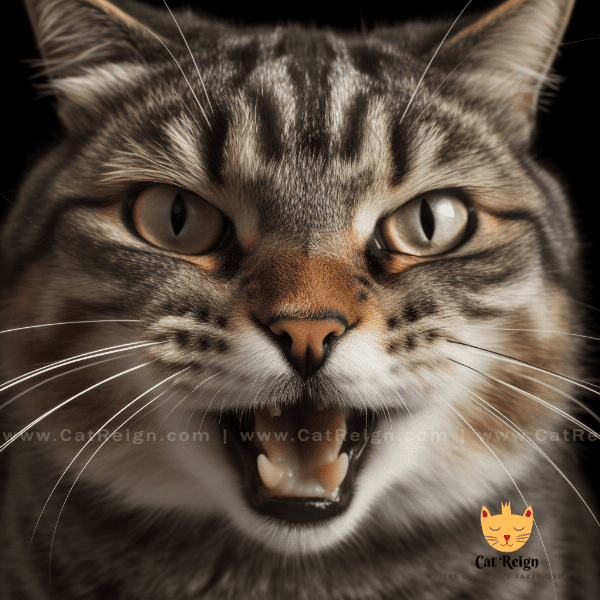Table of Contents
- The Science Behind Why Kittens Meow
- The Different Types of Meows and What They Mean
- Understanding Your Kitten’s Vocalizations
- Tips for Calming a Meowing Kitten
- Fun Ways to Play with Your Kitten and Encourage Meowing
- Capturing the Cutest Kitten Meow Sounds on Camera
- Health Concerns to Look Out for if Your Kitten is Meowing Excessively
- Training Your Kitten to Meow on Command
- Other Sounds Your Kitten Makes and What They Indicate
- The Joy of Sharing Your Home with Meowing Kittens.
The Science Behind Why Kittens Meow
Kittens are known for their high-pitched, adorable meows. But have you ever wondered why they meow in the first place? In this section, we’ll dive into the science behind why kittens meow and what causes them to make these delightful sounds.
Kittens Meow for Attention and Communication
One of the primary reasons why kittens meow is to get attention from their caretakers. As kittens are still developing their other senses, such as sight and smell, meowing becomes a crucial way for them to communicate with humans. Kittens may meow to indicate that they are hungry, thirsty, or need to use the litter box. Additionally, meowing can be a way for kittens to seek comfort and attention from their human companions.
Meowing is Part of Kitten Development
Meowing is a natural part of a kitten’s development. Newborn kittens will often meow to signal to their mother that they are hungry or cold. As kittens grow older, their meows will become more complex and nuanced. They may use different tones and pitches to communicate different needs or emotions.
Kittens Meow to Communicate with Other Cats
Meowing is not only a way for kittens to communicate with humans but also with other cats. Adult Cats use a range of vocalizations to communicate with each other, and kittens learn from observing and mimicking their behavior. As kittens grow and interact with other cats, their meows may become more sophisticated and vary in tone, pitch, and duration.
Meowing Can Indicate a Problem
While meowing is a natural behavior for kittens, excessive meowing can indicate an underlying issue. If your kitten is meowing excessively, it could be a sign of pain, illness, or stress. It’s important to pay attention to your kitten’s behavior and seek veterinary care if you notice any unusual changes in their meowing habits.
In summary, kittens meow for a variety of reasons, including to communicate with humans and other cats, seek attention, and indicate their needs. Understanding why kittens meow can help you better communicate with your furry friend and ensure their needs are being met.
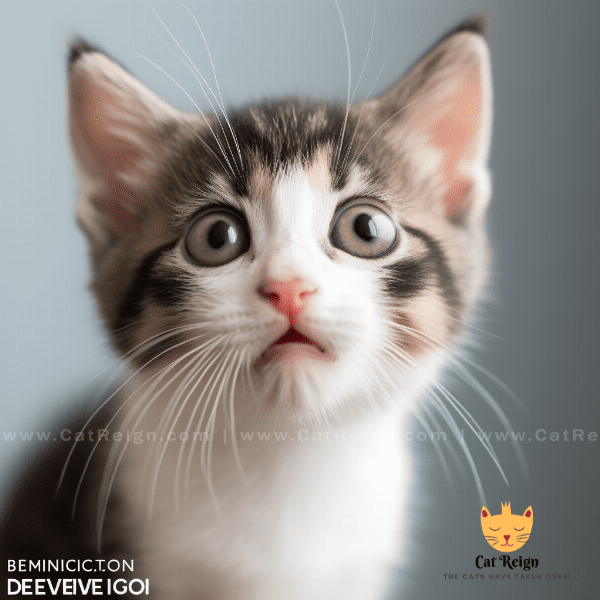
The Different Types of Meows and What They Mean
Kittens use a variety of meows to communicate their needs, emotions, and desires. In this section, we’ll explore the different types of meows and what they can mean.
The Hunger Meow
The hunger meow is perhaps the most recognizable of all kitten meows. This meow is usually high-pitched and urgent, and it indicates that your kitten is hungry and ready for a meal. Your kitten may also rub against your legs and follow you around to get your attention and indicate their hunger.
The Play Meow
The play meow is a bit different from other types of meows. It’s typically higher-pitched and more playful in tone. Your kitten may use this meow when they want to engage with you in playtime. They may also use this meow when they want to play with other cats or toys.
The Purr Meow
The purr meow is a low, rumbling sound that indicates contentment and happiness. Kittens may purr when they are being petted or cuddled, or when they are feeling comfortable and secure. The purr meow is a sign that your kitten is relaxed and enjoying their time with you.
The Demand Meow
The demand meow is a more insistent and urgent meow that indicates your kitten wants something specific. This could be food, water, attention, or access to a particular area of your home. The demand meow is usually louder and more persistent than other meows and may require a response from you.
The Greeting Meow
The greeting meow is a friendly, welcoming meow that kittens use when they see their owners or other cats. This meow may be accompanied by purring or rubbing against your legs. The greeting meow is a sign that your kitten is happy to see you and is looking for attention and affection.
In conclusion, understanding the different types of meows and what they mean can help you communicate more effectively with your kitten. By paying attention to their meows, you can determine what they need and respond accordingly, strengthening the bond between you and your furry friend.

Understanding Your Kitten’s Vocalizations
Kittens use a variety of vocalizations to communicate their needs and desires. Understanding what your kitten is trying to say can help you better care for them and strengthen your bond. In this section, we’ll explore some tips for understanding your kitten’s vocalizations.
Pay Attention to the Context
One of the most important things you can do when trying to understand your kitten’s vocalizations is to pay attention to the context. The same meow can mean different things in different situations. For example, a meow when your kitten is hungry will sound different from a meow when they want to play. By observing your kitten’s behavior and environment, you can better understand what they are trying to communicate.
Look for Body Language Cues
Kittens also use body language to communicate their needs and emotions. Paying attention to your kitten’s posture, tail position, and ear movements can give you clues about what they are trying to say. For example, a kitten with an arched back and puffed-up tail may be feeling scared or threatened, while a relaxed kitten with a tail held high may be feeling confident and happy.
Be Patient and Observant
Understanding your kitten’s vocalizations takes time and patience. Kittens will develop their meows and body language over time, and it’s important to observe and be patient as they learn to communicate their needs and desires. By taking the time to listen and watch your kitten, you can develop a deeper understanding of their unique vocalizations and strengthen your bond.
In summary, understanding your kitten’s vocalizations requires paying attention to context, observing body language cues, using positive reinforcement, and being patient and observant. By taking the time to understand your kitten’s unique vocalizations, you can better care for them and create a strong bond between you and your furry friend.
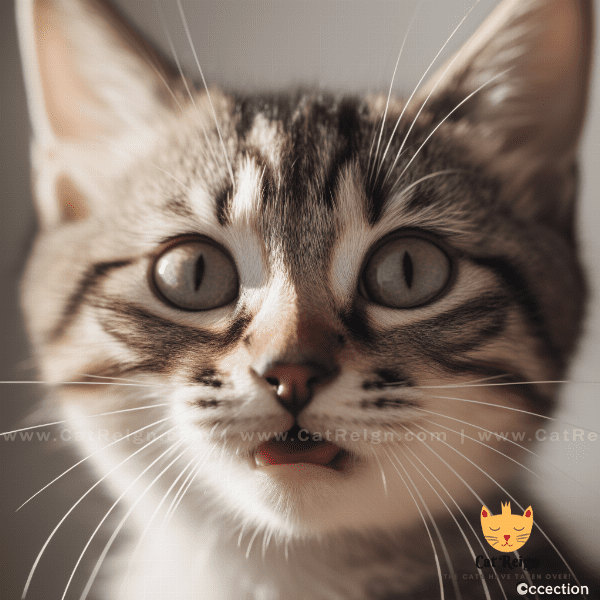
Tips for Calming a Meowing Kitten
Kittens can meow for a variety of reasons, including hunger, thirst, boredom, or anxiety. While meowing is a natural behavior, excessive or persistent meowing can be a sign of stress or discomfort. In this section, we’ll explore some tips for calming a meowing kitten and promoting a sense of calm and relaxation.
Provide a Safe and Comfortable Environment
One of the best ways to calm a meowing kitten is to provide a safe and comfortable environment. Make sure your kitten has access to clean water, a litter box, and a comfortable bed. Providing toys and playtime can also help relieve stress and anxiety. Additionally, creating a quiet and calm atmosphere can help promote relaxation.
Establish a Routine
Establishing a routine can help reduce anxiety and stress in your kitten. Try to feed your kitten at the same time each day and establish a regular playtime routine. This can help your kitten feel more secure and reduce the likelihood of excessive meowing.
Provide Positive Reinforcement
When your kitten is calm and relaxed, provide positive reinforcement. This could be in the form of treats, praise, or cuddles. By rewarding calm and relaxed behavior, you can encourage your kitten to repeat these behaviors in the future.
Use Pheromone Sprays or Diffusers
Pheromone sprays or diffusers can also be effective in calming a meowing kitten. These products release synthetic versions of natural pheromones that help promote a sense of calm and relaxation. They can be particularly effective in reducing meowing caused by separation anxiety or other stressful situations.
Consider Consultation with a Veterinarian
If your kitten’s meowing persists despite these efforts, it may be worth consulting with a veterinarian. Excessive meowing can be a sign of underlying health issues, such as pain or illness. A veterinarian can help determine the underlying cause of your kitten’s meowing and recommend appropriate treatment options.
In conclusion, calming a meowing kitten requires providing a safe and comfortable environment, establishing a routine, providing positive reinforcement, using pheromone sprays or diffusers, and consulting with a veterinarian if necessary. By taking a proactive approach to addressing excessive meowing, you can help promote a sense of calm and relaxation in your furry friend.
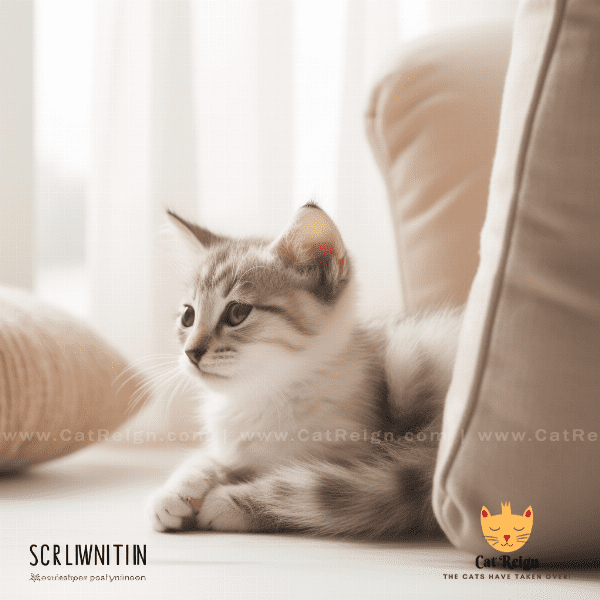
Fun Ways to Play with Your Kitten and Encourage Meowing
Playtime is an essential part of a kitten’s development, and it’s also a great way to encourage meowing and strengthen your bond. In this section, we’ll explore some fun ways to play with your kitten and encourage them to meow.
Interactive Toys
Interactive toys, such as feather wands or laser pointers, can be a great way to encourage your kitten to play and meow. These toys allow your kitten to engage in natural hunting behaviors and provide an opportunity for you to bond with your furry friend.
Hide and Seek
Playing hide and seek with your kitten can be a fun way to encourage meowing and promote exercise. Hide treats or toys around your home and encourage your kitten to find them. You can also hide and call out to your kitten, encouraging them to meow and seek you out.
Catnip Playtime
Catnip is a natural herb that can produce a euphoric and playful response in cats. Giving your kitten a toy or scratching post infused with catnip can encourage play and meowing. However, not all cats respond to catnip, so be sure to monitor your kitten’s behavior and response.
Training Games
Training games, such as teaching your kitten to meow on command, can be a fun and rewarding way to encourage meowing. Start by saying “meow” when your kitten naturally meows, and then gradually add in the command. Once your kitten has learned the command, you can reward them with treats or playtime.
Music and Dance Party
Playing music and having a dance party with your kitten can be a fun and entertaining way to encourage meowing and promote exercise. Choose upbeat music and encourage your kitten to dance and meow along with you.
In summary, there are many fun ways to play with your kitten and encourage them to meow. Interactive toys, hide and seek, catnip playtime, training games, and music and dance parties are just a few examples. By engaging in regular playtime and encouraging meowing, you can promote a healthy and happy bond with your furry friend.
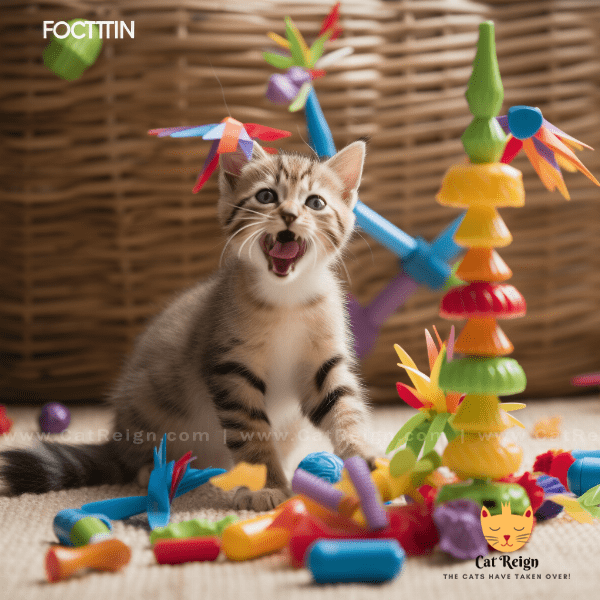
Capturing the Cutest Kitten Meow Sounds on Camera
Kitten meows are some of the cutest and most endearing sounds a cat can make. Capturing these sounds on camera can be a great way to preserve memories and share them with others. In this section, we’ll explore some tips for capturing the cutest kitten meow sounds on camera.
Choose the Right Equipment
Choosing the right equipment is essential when it comes to capturing kitten meow sounds on camera. A high-quality microphone, such as a lapel or directional microphone, can help capture clear and crisp sounds. Additionally, a camera with good video and audio capabilities can help you capture high-quality footage.
Record in a Quiet Environment
When recording kitten meow sounds, it’s important to do so in a quiet environment. Background noise, such as appliances or outside sounds, can make it difficult to capture clear audio. Choose a quiet room or space and turn off any background noise.
Encourage Meowing
To capture the cutest kitten meow sounds, encourage your kitten to meow naturally. Play with your kitten or use toys to stimulate them and encourage vocalizations. Be patient and wait for the right moment to capture the perfect meow sound.
Get Close to Your Kitten
To capture the clearest and most detailed meow sounds, get as close to your kitten as possible. This will ensure that the microphone is picking up the sound directly and reducing any ambient noise.
Use Editing Software
After recording your kitten’s meow sounds, use editing software to enhance the audio quality and remove any unwanted background noise. This can help make your kitten’s meow sounds even cuter and more appealing.
In conclusion, capturing the cutest kitten meow sounds on camera requires choosing the right equipment, recording in a quiet environment, encouraging meowing, getting close to your kitten, and using editing software to enhance the audio quality. By following these tips, you can preserve precious memories and share the cuteness of your furry friend with others.

Health Concerns to Look Out for if Your Kitten is Meowing Excessively
While meowing is a natural behavior for kittens, excessive or persistent meowing can be a sign of underlying health concerns. In this section, we’ll explore some health concerns to look out for if your kitten is meowing excessively.
Illness or Pain
Excessive meowing can be a sign of illness or pain in your kitten. If your kitten’s meowing is accompanied by other symptoms, such as lethargy, loss of appetite, or vomiting, it may be worth consulting with a veterinarian. They can help determine the underlying cause of your kitten’s meowing and recommend appropriate treatment options.
Anxiety or Stress
Excessive meowing can also be a sign of anxiety or stress in your kitten. Changes in routine or environment, such as moving to a new home or introducing a new pet, can trigger anxiety and result in excessive meowing. Providing a safe and comfortable environment and using pheromone sprays or diffusers can help reduce anxiety and promote relaxation.
Hunger or Thirst
Persistent meowing may also be a sign that your kitten is hungry or thirsty. Make sure your kitten has access to clean water and appropriate food, and consider feeding them smaller, more frequent meals throughout the day. If your kitten’s meowing persists despite these efforts, it may be worth consulting with a veterinarian.
Attention-Seeking Behavior
Some kittens may meow excessively as a way to seek attention from their owners. Providing regular playtime and positive reinforcement can help reduce attention-seeking behavior and promote positive interactions with your kitten.
In summary, excessive meowing in kittens can be a sign of underlying health concerns, such as illness or pain, anxiety or stress, hunger or thirst, or attention-seeking behavior. If your kitten’s meowing persists despite your efforts to address it, it may be worth consulting with a veterinarian. By staying vigilant and addressing health concerns promptly, you can help ensure the health and well-being of your furry friend.

Training Your Kitten to Meow on Command
Teaching your kitten to meow on command can be a fun and rewarding way to strengthen your bond and promote positive behavior. In this section, we’ll explore some tips for training your kitten to meow on command.
Start with Natural Meowing
The first step in training your kitten to meow on command is to start with natural meowing. When your kitten naturally meows, say the word “meow” and reward them with praise or treats. Repeat this process consistently until your kitten associates the word “meow” with the act of meowing.
Use Positive Reinforcement
Positive reinforcement is key when it comes to training your kitten to meow on command. Reward your kitten with treats or playtime every time they successfully meow on command. This will encourage your kitten to repeat the behavior in the future.
Be Consistent
Consistency is essential when it comes to training your kitten to meow on command. Use the same word and tone of voice every time you give the command, and reward your kitten consistently for successful meowing. This will help your kitten understand what is expected of them and reinforce positive behavior.
Gradually Increase the Difficulty
Once your kitten has learned to meow on command, gradually increase the difficulty of the task. For example, you can ask your kitten to meow in different locations or in the presence of distractions. This will help your kitten develop their meowing skills and reinforce positive behavior in a variety of situations.
Don’t Overdo It
Training your kitten to meow on command should be a fun and rewarding experience, but it’s important not to overdo it. Avoid repeating the command too often or using it in inappropriate situations. This can cause your kitten to become confused or anxious and may discourage them from meowing in the future.
In conclusion, training your kitten to meow on command requires starting with natural meowing, using positive reinforcement, being consistent, gradually increasing the difficulty, and avoiding overdoing it. By following these tips, you can teach your kitten a fun and rewarding trick and strengthen your bond with your furry friend.

Other Sounds Your Kitten Makes and What They Indicate
While meowing is one of the most common sounds kittens make, they can also vocalize in a variety of other ways. In this section, we’ll explore some other sounds your kitten makes and what they indicate.
Purring
Purring is a soft and soothing sound that cats make when they’re content and relaxed. Your kitten may purr when they’re being petted, cuddled, or just feeling happy and relaxed.
Hissing
Hissing is a defensive sound that cats make when they feel threatened or scared. Your kitten may hiss when encountering new people or animals or when feeling threatened in some way.
Chirping
Chirping is a unique sound that some cats make when they see birds or other small animals. Your kitten may chirp as a way to mimic the sound of prey and express their excitement or curiosity.
Growling
Growling is a low and guttural sound that cats make when they’re feeling threatened or angry. Your kitten may growl when encountering a perceived threat or when feeling territorial or defensive.
Chattering
Chattering is a rapid and chattering sound that some cats make when they see prey, such as birds or insects. Your kitten may chatter as a way to express their excitement and desire to hunt.
In summary, while meowing is the most common sound kittens make, they can also vocalize in a variety of other ways. Purring indicates contentment and relaxation, hissing indicates fear or aggression, chirping indicates excitement or curiosity, growling indicates anger or defensiveness, and chattering indicates excitement and the desire to hunt. Understanding these different vocalizations can help you better communicate with your furry friend and strengthen your bond.
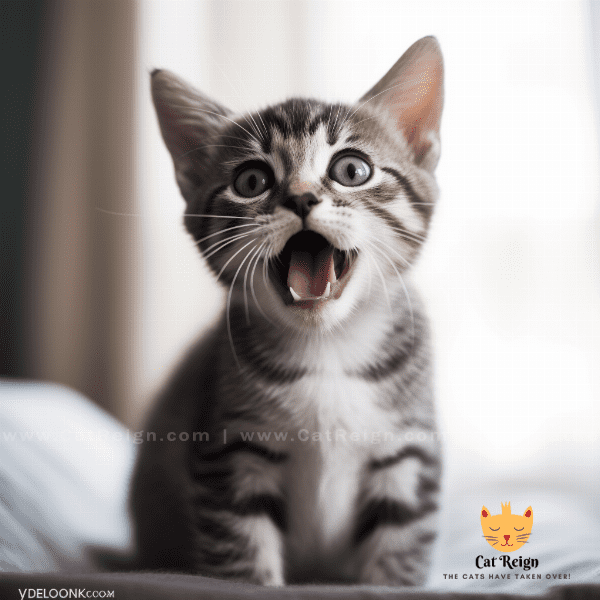
The Joy of Sharing Your Home with Meowing Kittens.
Sharing your home with meowing kittens can be a truly delightful and rewarding experience. In this section, we’ll explore some of the joys of living with meowing kittens.
Endless Entertainment
Kittens are naturally playful and curious, and their meows and other vocalizations can be endlessly entertaining. Watching your kitten play with toys, chase after imaginary prey, or just explore their environment can provide hours of entertainment and joy.
Unconditional Love and Affection
Kittens are known for their loving and affectionate personalities, and their meows can be a way of expressing their love and desire for attention. Snuggling up with your kitten and hearing their soft purrs and meows can be a wonderful way to feel loved and appreciated.
A Stronger Bond
Meowing can be a way for kittens to communicate and bond with their owners. By responding to your kitten’s vocalizations and engaging in play and affection, you can strengthen your bond and create a deeper connection with your furry friend.
A Sense of Responsibility
Caring for a meowing kitten can also provide a sense of responsibility and purpose. Ensuring that your kitten is well-fed, healthy, and happy can be a fulfilling and rewarding experience.
Health Benefits
Studies have shown that living with cats can have numerous health benefits, including reducing stress and anxiety and lowering blood pressure. The joy of living with meowing kittens can contribute to these benefits and promote overall health and well-being.
In conclusion, sharing your home with meowing kittens can be a truly joyful and rewarding experience. From endless entertainment and unconditional love to a stronger bond and a sense of responsibility, the benefits of living with meowing kittens are numerous. By embracing these joys and providing your kitten with a loving and nurturing home, you can create a happy and fulfilling life for both you and your furry friend.




